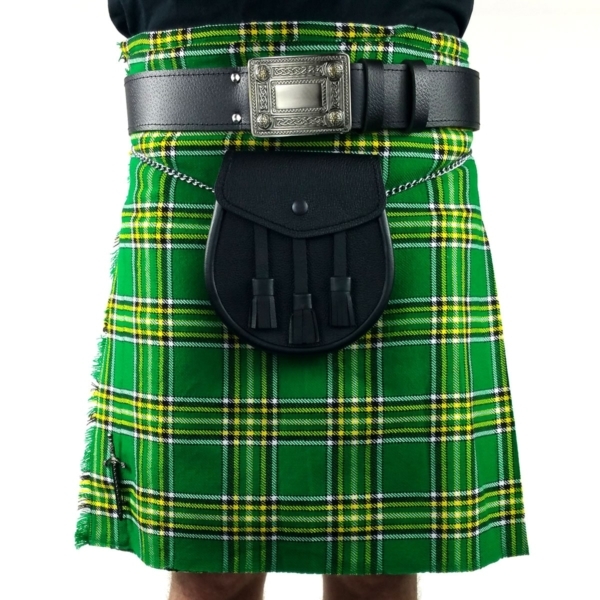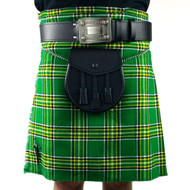Do the Irish Wear Kilts?
Posted by The Celtic Croft on Nov 20th 2019
Well, do the Irish wear kilts?
Of course, they do. Otherwise, we wouldn’t be in business. If you don’t believe us, take a gander at our web site Kilts-N-Stuff, where we specialize in all things Celtic, including Kilts.
Yes, we know most people associate kilts with Scotland and the Scottish Highlands. They can’t help it, and the movie Braveheart doesn’t help either. Funny how Mel Gibson’s character, a 13-century warrior, was wearing a kilt during a battle with England, even though the kilt is a 16th/17-century garment.
A Bit of History
But back to our original topic. Yes, the Irish wear kilts, but haven’t worn them as long as our friends the Scots have worn kilts. But no matter the time frame, Irish kilt-wearing is becoming more fashionable. And here at The Celtic Croft, we have a variety of styles of kilts you can choose from, no matter your budget.
Is the Irish kilt a traditional ancient garment? There are some legends and stories that say the kilt has been worn in Ireland as far back as the 16th century. Although many historians feel kilt-wearing only dates back to the beginning of the 20th century as a sign of nationalism and Celtic pride, in response to ongoing anglicization of Ireland.
A few Irish nationalists, like Sir Shane Leslie and William Gibsons, 2nd Baron Ashborne, began wearing kilts during the late 1800s and early 1900s.
There has been some representation of Irish men in the 16th century wearing garments resembling kilts, but this wasn’t the modern-day version of kilts. The garments did consist of heavily-pleated skirts, but these garments were leines, or the Irish tunic, which were long shirts with wide, hanging sleeves and elaborately pleated skirts.
Nevertheless, Irish kilt history is an exciting subject and continues to be discussed and debated by historians. While Scottish kilts can be dated back more than 300 years, Irishmen only started wearing kilts for little more than 100 years.
Regardless of when the Irish began wearing kilts, in today’s modern world, kilts have become fashionable clothing for all manner of special occasions, events, and festivals.

Scottish versus Irish Kilts
At first glance, Irish kilts, such as our Irish Tartan Kilts, may resemble one worn by a Scot. But take a closer look, and you see three differences: (1) the kilt’s material, (2) the jacket style, and (3) the accessories and details.
The Material
One of the most significant differences is the tartan. In the Scottish tradition, the wearer’s kilt uses the wearer’s family’s tartan as source material. For the Irish kilt wearer, the tartan is either plain colors that reflect the location or county of the wearer’s family origin.
While there is a tartan for every Irish County, you can use a tartan finder to search for suggestions using your last name. If you’re not quite sure of your name’s historical roots, don’t feel sad. There are a plethora of generic and universal Irish tartans for people of Irish descent, such as the “All Ireland,” from which to choose from for your kilt.
The Jacket
The jacket is another difference between the Scottish and the Irish Kilts. With Scottish Kilts, a Scottish Argyle is more commonly worn. The Irish counterparts are the Brian Boru, or the Kilkenny jacket. The Brian Boru is commonly worn at formals, or “black tie” occasions, while the Kilkenny, which structure is similar to a business suit jacket, is ideal for day or evening wear.

The Accessories
In Scotland and Ireland, kilts wearers also wear knee-high socks with ribbons to match the color of the Tartan, and Ghillie Brogues on the feet. The majority of times, the socks cream-colored, although Irish military members wear black socks with the Saffron Kilts.
While originating in Scotland, the tradition of wearing a sgian dubh has spread to the Irish. The wearer places a Sgian-dubh inside the sock on the side of the wearer’s dominant hand. The Sgian-dubh was used originally for eating and meal preparation.
Protection against attacks was another use for the Sgian-dubh. Today, the wearer inserts the knife into the top of the kilt hose, with the upper part of the hilt visible.

Which Kilt to Wear
Going to a wedding or just want to relive a bit of your ancestral history? There are many variations of the Irish kilt, and some mirror the tartans of the Scottish varieties.
From our traditional Scottish Feileadh Mòr, or Great Kilts, to the Ancient Kilts, to our “feilidh-beag,” Kilts-N-Stuff will outfit you in any kilt your heart desires — including kilts in the same style as the ones worn in Braveheart. A Homespun Wool Blend Irish Ancient Kilts is perfect for reenactment events, weddings, and Renaissance festivals.
A more traditional kilt associated with Ireland is the Saffron Kilt. The Saffron color is mustard yellow, traditionally the “color of the kings,” and harkens back to Ireland’s medieval period, and also honors Irish military men. The kilts often have shamrock appliques on the pleats.
Patrick Pearse, an Easter Uprising revolutionary, and headmaster of St. Enda’s School for Boys, chose the saffron kilt for the school’s uniform. Not long after, many Irish regiments of the British Army adopted the saffron kilt for their pipers. Irish dancers at the time were known to wear solid-colored kilts.
As kilt-wearing has become more popular, it is not surprising to see individuals wear kilts in casual settings.
For a more casual setting, try a Light Weight Irish Premium Wool Casual Kilt. At Kilts-N-Stuff, our lightweight Irish Kilts are handcrafted to your measurements by skilled kiltmakers and made from medium-weight 100% premium wool tartan. And we guarantee your kit will fit.

Unsure which kilt is right for you? Don’t worry, the staff at The Celtic Croft will help you get suited up.
Kilting may not be an old Irish custom, or as old as their Scottish counterparts, but it is fast becoming a grand custom.

